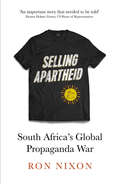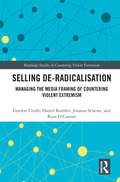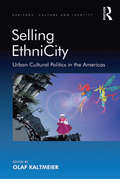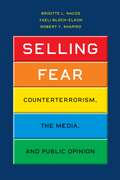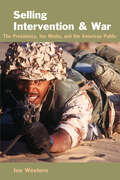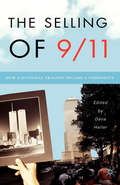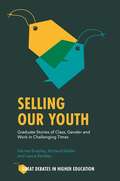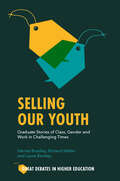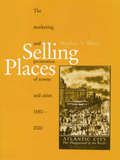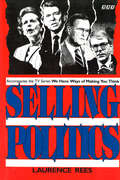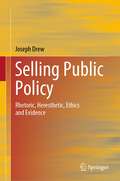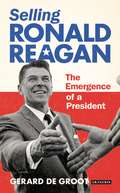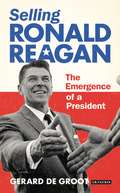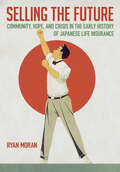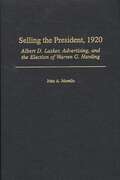- Table View
- List View
Selling Apartheid: South Africa's Global Propaganda War
by Ron NixonThis book lays bare the global propaganda war waged by the South African government in the attempt to bolster support for their apartheid regime. The world-wide campaign consisted of the government burnishing its image overseas, selling apartheid to the US and the UK in particular. *BR**BR*Costing around $100 million annually, and run with vigourous efficiency for fifty years, the campaign drew in an elaborate network of supporters, including global corporations with business operations in South Africa, conservative religious organisations, and an unlikely coalition of liberal black clergy and anti-communist black conservatives aligned with right-wing Cold War politicians. *BR**BR*Journalist Ron Nixon brings together interviews with key players, and thousands of previously unreleased records from US, British and South African archives, to provide a fast-paced and historically rich account of a little-known history.
Selling De-Radicalisation: Managing the Media Framing of Countering Violent Extremism (Routledge Studies in Countering Violent Extremism)
by Gordon Clubb Daniel Koehler Jonatan Schewe Ryan O'ConnorThis book examines how de-radicalisation programmes have been portrayed in the media and details the role of public relations (PR) strategies employed by such programmes and Countering Violent Extremism (CVE) to create positive coverage of their work. CVE and de-radicalisation programmes have seen a significant rise in recent years and are now cornerstones of many countries’ counterterrorism strategies. Despite the increased importance of these tools to counter violent radicalisation leading to terrorism, they remain controversial and sometimes receive fierce public criticism and opposition. This work looks at how CVE and de-radicalisation programs are able to influence a country’s discourse on de-radicalisation, and how far governmental programs differ from non-governmental initiatives in terms of their PR strategies. The book also provides a theoretical basis of how the discourse on CVE is constructed in the media. As major case studies, this book examines the United Kingdom, Germany and Nigeria. For these countries, the authors have gathered and assessed roughly 3,000 newspaper articles on de-radicalisation programmes over a decade to provide an empirical base. This book will be of much interest to students of countering violent extremism, de-radicalisation, and terrorism studies.
Selling De-Radicalisation: Managing the Media Framing of Countering Violent Extremism (Routledge Studies in Countering Violent Extremism)
by Gordon Clubb Daniel Koehler Jonatan Schewe Ryan O'ConnorThis book examines how de-radicalisation programmes have been portrayed in the media and details the role of public relations (PR) strategies employed by such programmes and Countering Violent Extremism (CVE) to create positive coverage of their work. CVE and de-radicalisation programmes have seen a significant rise in recent years and are now cornerstones of many countries’ counterterrorism strategies. Despite the increased importance of these tools to counter violent radicalisation leading to terrorism, they remain controversial and sometimes receive fierce public criticism and opposition. This work looks at how CVE and de-radicalisation programs are able to influence a country’s discourse on de-radicalisation, and how far governmental programs differ from non-governmental initiatives in terms of their PR strategies. The book also provides a theoretical basis of how the discourse on CVE is constructed in the media. As major case studies, this book examines the United Kingdom, Germany and Nigeria. For these countries, the authors have gathered and assessed roughly 3,000 newspaper articles on de-radicalisation programmes over a decade to provide an empirical base. This book will be of much interest to students of countering violent extremism, de-radicalisation, and terrorism studies.
Selling EthniCity: Urban Cultural Politics in the Americas
by Olaf KaltmeierBringing together a multidisciplinary team of scholars, this book explores the importance of ethnicity and cultural economy in the post-Fordist city in the Americas. It argues that cultural, political and economic elites make use of cultural and ethnic elements in city planning and architecture in order to construct a unique image of a particular city and demonstrates how the use of ethnicized cultural production - such as urban branding based on local identities - by the economic elite raises issues of considerable concern in terms of local identities, as it deploys a practical logic of capital exchange that can overcome forms of cultural resistance and strengthen the hegemonic colonization of everyday life. At the same time, it shows how ethnic communities are able to use ethnic labelling of cultural production, ethnic economy or ethno-tourism facilities in order to change living conditions and to empower its members in ways previously impossible. Of wide ranging interest across academic disciplines, this book will be a useful contribution to Inter-American studies.
Selling EthniCity: Urban Cultural Politics in the Americas
by Olaf KaltmeierBringing together a multidisciplinary team of scholars, this book explores the importance of ethnicity and cultural economy in the post-Fordist city in the Americas. It argues that cultural, political and economic elites make use of cultural and ethnic elements in city planning and architecture in order to construct a unique image of a particular city and demonstrates how the use of ethnicized cultural production - such as urban branding based on local identities - by the economic elite raises issues of considerable concern in terms of local identities, as it deploys a practical logic of capital exchange that can overcome forms of cultural resistance and strengthen the hegemonic colonization of everyday life. At the same time, it shows how ethnic communities are able to use ethnic labelling of cultural production, ethnic economy or ethno-tourism facilities in order to change living conditions and to empower its members in ways previously impossible. Of wide ranging interest across academic disciplines, this book will be a useful contribution to Inter-American studies.
Selling Fear: Counterterrorism, the Media, and Public Opinion (Chicago Studies in American Politics)
by Brigitte L. Nacos Yaeli Bloch-Elkon Robert Y. ShapiroWhile we’ve long known that the strategies of terrorism rely heavily on media coverage of attacks, Selling Fear is the first detailed look at the role played by media in counterterrorism—and the ways that, in the wake of 9/11, the Bush administration manipulated coverage to maintain a climate of fear. Drawing on in-depth analysis of counterterrorism in the years after 9/11—including the issuance of terror alerts and the decision to invade Iraq—the authors present a compelling case that the Bush administration hyped fear, while obscuring civil liberties abuses and concrete issues of preparedness. The media, meanwhile, largely abdicated its watchdog role, choosing to amplify the administration’s message while downplaying issues that might have called the administration’s statements and strategies into question. The book extends through Hurricane Katrina, and the more skeptical coverage that followed, then the first year of the Obama administration, when an increasingly partisan political environment presented the media, and the public, with new problems of reporting and interpretation. Selling Fear is a hard-hitting analysis of the intertwined failures of government and media—and their costs to our nation.
Selling Fear: Counterterrorism, the Media, and Public Opinion (Chicago Studies in American Politics)
by Brigitte L. Nacos Yaeli Bloch-Elkon Robert Y. ShapiroWhile we’ve long known that the strategies of terrorism rely heavily on media coverage of attacks, Selling Fear is the first detailed look at the role played by media in counterterrorism—and the ways that, in the wake of 9/11, the Bush administration manipulated coverage to maintain a climate of fear. Drawing on in-depth analysis of counterterrorism in the years after 9/11—including the issuance of terror alerts and the decision to invade Iraq—the authors present a compelling case that the Bush administration hyped fear, while obscuring civil liberties abuses and concrete issues of preparedness. The media, meanwhile, largely abdicated its watchdog role, choosing to amplify the administration’s message while downplaying issues that might have called the administration’s statements and strategies into question. The book extends through Hurricane Katrina, and the more skeptical coverage that followed, then the first year of the Obama administration, when an increasingly partisan political environment presented the media, and the public, with new problems of reporting and interpretation. Selling Fear is a hard-hitting analysis of the intertwined failures of government and media—and their costs to our nation.
Selling Fear: Counterterrorism, the Media, and Public Opinion (Chicago Studies in American Politics)
by Brigitte L. Nacos Yaeli Bloch-Elkon Robert Y. ShapiroWhile we’ve long known that the strategies of terrorism rely heavily on media coverage of attacks, Selling Fear is the first detailed look at the role played by media in counterterrorism—and the ways that, in the wake of 9/11, the Bush administration manipulated coverage to maintain a climate of fear. Drawing on in-depth analysis of counterterrorism in the years after 9/11—including the issuance of terror alerts and the decision to invade Iraq—the authors present a compelling case that the Bush administration hyped fear, while obscuring civil liberties abuses and concrete issues of preparedness. The media, meanwhile, largely abdicated its watchdog role, choosing to amplify the administration’s message while downplaying issues that might have called the administration’s statements and strategies into question. The book extends through Hurricane Katrina, and the more skeptical coverage that followed, then the first year of the Obama administration, when an increasingly partisan political environment presented the media, and the public, with new problems of reporting and interpretation. Selling Fear is a hard-hitting analysis of the intertwined failures of government and media—and their costs to our nation.
Selling Fear: Counterterrorism, the Media, and Public Opinion (Chicago Studies in American Politics)
by Brigitte L. Nacos Yaeli Bloch-Elkon Robert Y. ShapiroWhile we’ve long known that the strategies of terrorism rely heavily on media coverage of attacks, Selling Fear is the first detailed look at the role played by media in counterterrorism—and the ways that, in the wake of 9/11, the Bush administration manipulated coverage to maintain a climate of fear. Drawing on in-depth analysis of counterterrorism in the years after 9/11—including the issuance of terror alerts and the decision to invade Iraq—the authors present a compelling case that the Bush administration hyped fear, while obscuring civil liberties abuses and concrete issues of preparedness. The media, meanwhile, largely abdicated its watchdog role, choosing to amplify the administration’s message while downplaying issues that might have called the administration’s statements and strategies into question. The book extends through Hurricane Katrina, and the more skeptical coverage that followed, then the first year of the Obama administration, when an increasingly partisan political environment presented the media, and the public, with new problems of reporting and interpretation. Selling Fear is a hard-hitting analysis of the intertwined failures of government and media—and their costs to our nation.
Selling Fear: Counterterrorism, the Media, and Public Opinion (Chicago Studies in American Politics)
by Brigitte L. Nacos Yaeli Bloch-Elkon Robert Y. ShapiroWhile we’ve long known that the strategies of terrorism rely heavily on media coverage of attacks, Selling Fear is the first detailed look at the role played by media in counterterrorism—and the ways that, in the wake of 9/11, the Bush administration manipulated coverage to maintain a climate of fear. Drawing on in-depth analysis of counterterrorism in the years after 9/11—including the issuance of terror alerts and the decision to invade Iraq—the authors present a compelling case that the Bush administration hyped fear, while obscuring civil liberties abuses and concrete issues of preparedness. The media, meanwhile, largely abdicated its watchdog role, choosing to amplify the administration’s message while downplaying issues that might have called the administration’s statements and strategies into question. The book extends through Hurricane Katrina, and the more skeptical coverage that followed, then the first year of the Obama administration, when an increasingly partisan political environment presented the media, and the public, with new problems of reporting and interpretation. Selling Fear is a hard-hitting analysis of the intertwined failures of government and media—and their costs to our nation.
Selling Fear: Counterterrorism, the Media, and Public Opinion (Chicago Studies in American Politics)
by Brigitte L. Nacos Yaeli Bloch-Elkon Robert Y. ShapiroWhile we’ve long known that the strategies of terrorism rely heavily on media coverage of attacks, Selling Fear is the first detailed look at the role played by media in counterterrorism—and the ways that, in the wake of 9/11, the Bush administration manipulated coverage to maintain a climate of fear. Drawing on in-depth analysis of counterterrorism in the years after 9/11—including the issuance of terror alerts and the decision to invade Iraq—the authors present a compelling case that the Bush administration hyped fear, while obscuring civil liberties abuses and concrete issues of preparedness. The media, meanwhile, largely abdicated its watchdog role, choosing to amplify the administration’s message while downplaying issues that might have called the administration’s statements and strategies into question. The book extends through Hurricane Katrina, and the more skeptical coverage that followed, then the first year of the Obama administration, when an increasingly partisan political environment presented the media, and the public, with new problems of reporting and interpretation. Selling Fear is a hard-hitting analysis of the intertwined failures of government and media—and their costs to our nation.
Selling Hitler: The Story of the Hitler Diaries
by Robert HarrisPRE-ORDER PRECIPICE, THE THRILLING NEW NOVEL FROM ROBERT HARRIS, NOW - PUBLISHING AUGUST 2024'Impossible to stop reading' OBSERVER'Thrilling, intricate and hilarious' DAILY MAILAPRIL 1945: From the ruins of Berlin, a Luftwaffe transport plane takes off carrying secret papers belonging to Adolf Hitler. Half an hour later, it crashes in flames.APRIL 1983: In a bank vault in Switzerland, a German magazine offers to sell more than 50 volumes of Hitler's secret diaries. The asking price is $4 million.40 years from the alleged discovery, Robert Harris chronicles the gripping tale of one of the biggest frauds in history.'Brilliantly chronicled' NEW STATESMAN'A masterly account' LITERARY REVIEW
Selling Intervention and War: The Presidency, the Media, and the American Public
by Jon WesternSelling Intervention and War examines the competition among foreign policy elites in the executive branch and Congress in winning the hearts and minds of the American public for military intervention. The book studies how the president and his supporters organize campaigns for public support for military action. According to Jon Western, the outcome depends upon information and propaganda advantages, media support or opposition, the degree of cohesion within the executive branch, and the duration of the crisis. Also important is whether the American public believes that military threat is credible and victory plausible. Not all such campaigns to win public support are successful; in some instances, foreign policy elites and the president and his advisors have to back off. Western uses several modern conflicts, including the current one in Iraq, as case studies to illustrate the methods involved in selling intervention and war to the American public: the decision not to intervene in French Indochina in 1954, the choice to go into Lebanon in 1958, and the more recent military actions in Grenada, Somalia, Bosnia, and Iraq. Selling Intervention and War is essential reading for scholars and students of U.S. foreign policy, international security, the military and foreign policy, and international conflict.
Selling Intervention and War: The Presidency, the Media, and the American Public
by Jon WesternSelling Intervention and War examines the competition among foreign policy elites in the executive branch and Congress in winning the hearts and minds of the American public for military intervention. The book studies how the president and his supporters organize campaigns for public support for military action. According to Jon Western, the outcome depends upon information and propaganda advantages, media support or opposition, the degree of cohesion within the executive branch, and the duration of the crisis. Also important is whether the American public believes that military threat is credible and victory plausible. Not all such campaigns to win public support are successful; in some instances, foreign policy elites and the president and his advisors have to back off. Western uses several modern conflicts, including the current one in Iraq, as case studies to illustrate the methods involved in selling intervention and war to the American public: the decision not to intervene in French Indochina in 1954, the choice to go into Lebanon in 1958, and the more recent military actions in Grenada, Somalia, Bosnia, and Iraq. Selling Intervention and War is essential reading for scholars and students of U.S. foreign policy, international security, the military and foreign policy, and international conflict.
The Selling of 9/11: How a National Tragedy Became a Commodity
The Selling of 9/11 argues that the marketing and commodification of the terrorist attacks of September 11, 2001, reveal the contradictory processes by which consumers in the United States (and around the world) use, communicate, and construct national identity and their sense of national belonging through cultural and symbolic goods. Contributors illuminate these processes and make important connections between myths of nation, practices of mourning, theories of trauma, and the politics of post-9/11 consumer culture. Their essays take critical stock of the role that consumer goods, media and press outlets, commercial advertising, marketers and corporate public relations have played in shaping cultural memory of a national tragedy.
Selling Our Youth: Graduate Stories of Class, Gender and Work in Challenging Times (Great Debates in Higher Education)
by Harriet Bradley Richard Waller Laura BentleySelling Our Youth explores how the class origins of recent graduates continue to shape their labour market careers and thus reproduce class privilege and class disadvantage. It shows how class and gender combine to influence these young adults’ opportunities and choices, in an era when this generation has been characterized as the first likely to end up worse off economically than their parents. The authors draw upon the landmark Paired Peers research project – an empirical longitudinal study of recent graduates in England – to explore their experiences of the contemporary globalized labour market. It demonstrates how many of these young, well qualified adults struggle to achieve stable and rewarding employment in the context of the overstocked graduate supply, precarious work and exploitative working conditions. Government policies of austerity, which were in place when these young people graduated in 2013, meant this generation faced the challenges of a lower wage economy and a housing crisis. The subsequent arrival of Covid-19 and its disastrous impacts on the local and global economy are making these challenges even tougher. The authors further explore the way differences of class and gender impact upon graduate trajectories.
Selling Our Youth: Graduate Stories of Class, Gender and Work in Challenging Times (Great Debates in Higher Education)
by Harriet Bradley Richard Waller Laura BentleySelling Our Youth explores how the class origins of recent graduates continue to shape their labour market careers and thus reproduce class privilege and class disadvantage. It shows how class and gender combine to influence these young adults’ opportunities and choices, in an era when this generation has been characterized as the first likely to end up worse off economically than their parents. The authors draw upon the landmark Paired Peers research project – an empirical longitudinal study of recent graduates in England – to explore their experiences of the contemporary globalized labour market. It demonstrates how many of these young, well qualified adults struggle to achieve stable and rewarding employment in the context of the overstocked graduate supply, precarious work and exploitative working conditions. Government policies of austerity, which were in place when these young people graduated in 2013, meant this generation faced the challenges of a lower wage economy and a housing crisis. The subsequent arrival of Covid-19 and its disastrous impacts on the local and global economy are making these challenges even tougher. The authors further explore the way differences of class and gender impact upon graduate trajectories.
Selling Places: The Marketing and Promotion of Towns and Cities 1850-2000 (Planning, History and Environment Series)
by Stephen WardSelling Places explores the fascinating development of the place marketing and promotion over the last 150 years, drawing on examples from Northern America, Britain and continental Europe. The processes involved and the promotional imagery employed are meticulously presented and richly illustrated.
Selling Places: The Marketing and Promotion of Towns and Cities 1850-2000 (Planning, History and Environment Series)
by Stephen WardSelling Places explores the fascinating development of the place marketing and promotion over the last 150 years, drawing on examples from Northern America, Britain and continental Europe. The processes involved and the promotional imagery employed are meticulously presented and richly illustrated.
Selling Politics: Accompanies the TV series We Have Ways Of Making You Think
by Laurence ReesSelling Politics investigates the secret world of political consultants, the men who create an image of their clients for the public eye.Author Laurence Rees argues that the roots of political propaganda lie in Nazi Germany with Hitler’s master of visual propaganda, Dr Josef Goebbels. Goebbels’ passion for cinema led him to discover the ‘Great Truth’, namely that in order for film propaganda to persuade it must entertain rather than inform. Over the past thirty years the use of film and television propaganda had flourished, particularly in the United States where a candidate’s ability to woo voters on the screen is fundamental to his success in a presidential election.Rees shows how television manipulates its viewers into making judgements based purely on the visual image and explains why propaganda works best when it engages the emotions rather than the intellect. We see clearly how these insidious techniques have also played a key role in contemporary British politics as consultants have followed the example of their American counterparts.Written in1992, a year that encompassed a general election in Britain and a presidential election in the United States, Selling Politics is a book for our times. It will fascinate readers who care about the practice of politics and the way democracy functions as the 21st century approaches.
Selling Public Policy: Rhetoric, Heresthetic, Ethics and Evidence
by Joseph DrewProfessor Drew’s latest work makes the case that even great public policy needs to be deliberately and strategically sold in order for it to ultimately be considered a success. However, it seems that most people charged with the task of selling public policy simply do not have the requisite skills to do so.Selling public policy is an art that draws on disparate strands of scholarship spanning the political sciences, economics, sociology, ethics and the classics. To perform the art of selling public policy one must first master the lessons from the greats in the field. Following this, it is necessary to learn how to apply the knowledge to real-world complex scenarios in such a way that the policy is indeed sold and stays sold over the implied returns period.This book is unique in the corpus of scholarly literature because it provides both the knowledge and real-world case studies required for students, scholars, and policy practitioners to master the art of selling public policy.
Selling Ronald Reagan: The Emergence of a President
by Gerard DeGrootBefore 1966, the idea of Reagan in politics provoked widespread scorn. To most people, he seemed a has-been actor, a right-wing extremist and a 'dunce'. Journalists therefore ridiculed his aspirations to be governor of California. No one, however, doubted his incredible ability to communicate with a crowd. In order to succeed in his campaign, Reagan had to be packaged as an outsider - an antidote to politics as usual. A highly sophisticated team of marketers and ad-men turned the scary right-winger into a harmless moderate who could attract supporters from across the political spectrum. Researchers meanwhile provided the coaching that allowed Reagan to seem well-informed - all of which led to Reagan winning the California governorship by a landslide. Gerard DeGroot here explores how, in the decade of consumerism, Reagan was marketed as a product. While there is no doubting his natural abilities as a campaigner, Reagan won in 1966 because his team of advisers understood how to sell their candidate, and he, wisely, allowed himself to be sold.Selling Ronald Reagan tells the story of Reagan's first election, when the nature of campaigning was forever altered and a titan of modern American history emerged.
Selling Ronald Reagan: The Emergence of a President
by Gerard DeGrootHow did Ronald Reagan go from being a washed-up Hollywood actor to the most powerful man in America? Running as a 'celebrity' candidate for the governorship of California in 1966, Ronald Reagan's hard-line republican campaign was faltering amongst the student riots in Berkeley and sixties counter-culture. Reagan's team, young. Hungry and inventive, including two Stanford psychologists, coached Reagan – teaching him to avoid getting caught up in policy detail and to refocus attention towards his natural ease in front of the camera and media-friendly charisma. In doing so Reagan and his team created the first 'modern' politician. With an emphasis on the importance of the sound-bite, the photo-op and Reagan's personality, they won the California governorship by a landslide, and went on to do the same in the US presidential elections.This is the untold story of Reagan's California campaign, which was to change the face of American politics, and sheds new light on one of the titans of modern American history.
Selling the Future: Community, Hope, and Crisis in the Early History of Japanese Life Insurance
by Ryan MoranIn Selling the Future, Ryan Moran explains how the life insurance industry in Japan exploited its association with mutuality and community to commodify and govern lives. Covering the years from the start of the industry in 1881 through the end of World War II, Moran describes insurance companies and government officials working together to create a picture of the future as precarious and dangerous. Since it was impossible for individual consumers to deal with every contingency on their own, insurance industry administrators argued that their usage of statistical data enabled them to chart the predictable future for the aggregate. Through insurance, companies and the state thus offered consumers a means to a perfectible future in an era filled with repeated crises. Life insurance functioned as an important modernist technology within Japan and its colonies to instantiate expectations for responsibility, to reconfigure meanings of mutuality, and to normalize new social formations (such as the nuclear family) as essential to life. Life insurance thus offers an important vehicle for examining the confluence of modes of mobilizing and organizing bodies, the expropriation of financial resources, and the action of disciplining workers into a capitalist system.
Selling the President, 1920: Albert D. Lasker, Advertising, and the Election of Warren G. Harding (Non-ser.)
by John A. MorelloModern advertising moved into the 20th century borne on many vehicles and distinguished by many techniques, three of the most frequently used being reason why advertising, celebrity endorsements, and pre-emptive claims. Best known for his reason why advertising, Albert Davis Lasker, president of the Lord & Thomas Agency of Chicago, championed all three techniques, helping Lucky Strike Cigarettes, Van Camp's Pork & Beans, and Sunkist Oranges become business successes. His least known but best work was in the political area, where he helped the Republicans gain control of Congress in 1918, and with the election of Warren G. Harding, recapture the White House in 1920.This book covers events leading to Harding's nomination and election and the key role Lasker played in his election. Bringing along the tricks he had used to sell soap, beer, cigarettes, and canned food, Lasker plunged into political advertising, forever changing the way political candidates are publicized.
